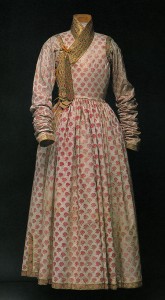
While silk, wool, and linen were the most plentiful fabrics during the eighteenth century, today cotton is cheap, easy to find, and comfortable for summer wear. But what should you look for when trying to approximate eighteenth-century cottons? What did Europeans and Americans wear in the period? And what’s the difference between calico, chintz, toile, and indienne, anyway?
In India, painted cottons (colors painted onto cloth by hand, either freehand or over a stencil) were developed in the fourteenth century. In the seventeenth century, Europeans began to import these fabrics, which were appreciated because of their bright colors, lightweight hand, and ease in laundering, as they expanded their trade networks. Their popularity increased as Europeans exported the technology of block printing to India, which made the fabrics easier and cheaper to manufacture, and as Indians adjusted their designs to appeal to European aesthetics.
Although some countries passed legislation against the import, manufacture, and sale of painted and printed cottons in order to protect domestic textile industries (as in France from 1686 to 1759 and England from 1700 to 1774), by the 1730s printed cottons were serious contenders in the European clothing and furniture market, with their largest popularity from the 1780s onwards. While most printed cottons continued to be manufactured in India until the 1790s, mills in England, France, Germany, the Netherlands, and Switzerland began to produce their own versions.
On both continents, printed cottons were created through a combination of mordant dyeing (fixative chemicals are printed onto the cloth, which is then dipped into the dye), resist dyeing (the fabric is coated by hand so that the coated areas do not absorb the dye color), relief printing (the design is cut out of a block, which is inked or coated with dye and then pressed onto the fabric), and hand painting. Until the nineteenth century, all dyes were derived from vegetable (or, less frequently, from animal or mineral) sources. Most eighteenth-century dyes were derived from madder, which creates a range of colors from pink to red, purple, and black. Blues and yellows were added by hand penciling the colors onto the fabric.
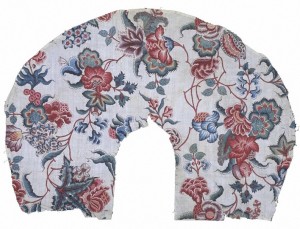
Most printed cottons used for clothing were based on floral designs. By mid-century, fabrics were imitating fashionable silk brocades with European flowers (tulips, carnations, roses, and daises) incorporated into more traditionally Indian motifs on a white background. In the 1780s, bolder designs with twisting stems became increasingly fashionable. In the 1790s, small floral “sprig” designs with tiny motifs on pastel backgrounds became cheap, and therefore became popular for working class clothing; also, some clothing fabrics veered away from the white backgrounds to include yellow, red, and brown.
In France, these printed fabrics (no matter their origin) were generally called indiennes (French for “Indians”), although they were also known as toiles peintes (“painted cloths”) and toiles imprimés (“printed cloths”). In England and the American colonies, there were similarly a number of terms used: calico, derived from the Indian port of Calicut, was a general name for Indian cotton fabric, including plain, printed, stained, dyed, woven with colored stripes or checks, etc.; chintz, from the Hindi word chint (“variegated”), was a term for printed or painted calicoes. The English and American colonialists also used the term Indiennes to refer to French-made copies of Indian printed cottons.
So what should you look for when shopping for reproduction fabric for eighteenth-century clothing? First, take a look through the websites and books in the source list to gain an “eye” for what is appropriate. Pay attention not only to the changing designs, but colors (including backgrounds), scale, where the fabric was made (India or Europe?), and what the fabric was used for (clothing or furnishings?). Keep in mind that throughout the century, most clothing fabrics had a white background until the 1790s; design colors were mainly pink/red/purple/brown, with possibly yellow and/or blue accents; and the designs usually consisted of spare florals in a sprig or striped motif.
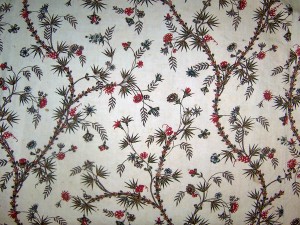
One of the most important points to remember is that what we now call “toile” (large scale scenic designs with people, trees, birds, and buildings printed in one color [red, blue, green, or brown] on white backgrounds) were only used for furnishings in the period. These fabrics were made using a technique called copperplate printing, developed in Europe in the 1760s at the famous Jouy textile manufactory.
HISTORICAL ACCURACY NOTE: Most modern cottons cannot perfectly reproduce fabrics created in the eighteenth century. Decorator fabric can be too heavy and have prints that are too large in scale; quilt fabric can be too light and too tightly woven. If you’re an historical accuracy purist, you may want to stay away from cotton prints altogether.
Links and sources
Books:
- Albrecht-Mathey, Elisabeth. The Fabrics of Mulhouse and Alsace 1750-1800. Leigh-on-Sea: P. Lewis, 1968.
- Beer, Alice Baldwin. Trade Goods: A Study of Indian Chintz in the Collection of the Cooper-Hewitt Museum of Decorative Arts and Design, Smithsonian Institution. Washington: Smithsonian Institution Press, 1970.
- Brédif, Josette. Toiles de Jouy: Classic Printed Textiles from France, 1760-1843. London: Thames & Hudson, 1989.
- Carlano, Marianne and Larry Salmon, eds. French Textiles: From the Middle Ages through the Second Empire. Hartford, Conn.: Wadsworth Atheneum, 1985.
- Clouzot, Henri. Painted and Printed Fabrics: The History of the Manufactory at Jouy and Other Ateliers in France, 1760-1815. New York: Arno Press, 1974.
- Crill, Rosemary. Chintz: Indian Textiles for the West. London: V&A Publications, 2008.
- Harris, Jennifer, ed. Textiles, 5,000 Years: An International and Illustrated Survey. New York: Harry Abrams, 1993.
- Irwin, John. Origins of Chintz, With a Catalogue of Indo-European Cotton-Paintings in the Victoria and Albert Museum, London, and the Royal Ontario Museum, Toronto. London: Her Majesty’s Stationery Office, 1970.
- Irwin, John. Indian Painted and Printed Fabrics. Ahmedabad: Calico Museum of Textiles, 1971.
- Montgomery, Florence M. Printed Textiles: English and American Cottons and Linens, 1700-1850. New York: Viking Press, 1970.
- Montgomery, Florence M. Textiles in America, 1650-1870. New York: W.W. Norton & Co., 1984.
- Pettit, Florence H. America’s Printed and Painted Fabrics 1600-1900. New York: Hastings House, 1970.
- Sandberg, Gosta. The Red Dyes: Cochineal, Madder, and Murex Purple. Asheville, N.C.: Lark Books, 1994.
- Rothstein, Natalie, ed. Barbara Johnson’s Album of Fashions and Fabrics. London: Thames and Hudson, 1987.
- Victoria and Albert Museum. English Chintz. London: Her Majesty’s Stationery Office, 1955.
- Victoria and Albert Museum. English Printed Textiles, 1720-1836. London: Her Majesty’s Stationery Office, 1960.
Websites:
- “L’Aventure des Indiennes en France,” Compagnie des Cent Associés
- “The ‘Indiennes,'” Musée de l’Impression sur Étoffes
- “American Toiles: Revolution and Romance,” The Fabric Museum
Reproduction Fabric Sources:
As costumers, we often think cotton = cheap! Unfortunately, you’ll quickly find that good reproduction 18th century cotton prints can run you as much as silk.
None of the fabric stores listed below are in any way recommended. I am simply listing the resources that I have found; please do your own research to make sure you find the best prices and purchase from reputable vendors! Also, I can’t verify that any of these fabrics will still be available for purchase at any time. This list is current as of February 28, 2008.
- Dutch Quilts offers a number of fabulous reproductions; of their current offerings, the “Wilhelmina,” “Hindeloopen,” “Zaanstreek,” and “Island Marken” fabrics (in ecru/madder red) look perfect for reproductions. Some of these fabrics are currently carried by Reproduction Fabrics.
- The French Rendezvous offers some fabrics that look quite possible.
- Ikea often carries fabric, curtains, sheets/quilt covers etc. that are would work perfectly.
- P&B Textiles released a series of fabrics a few years ago based on the DAR Museum collection; #17E and #15E are in original colors and look like good reproductionss. However, I haven’t been able to find any online dealers that still carry these fabrics so they may no longer be available.
- Renaissance Fabrics carries a few reproduction cotton prints that look fabulous.
- Reproduction Fabrics currently offers a number of fabrics in their 1775-1825 Fabrics category that could work. Pay close attention to prints and colors – some are great, some aren’t!
- Waverly fabrics has released a collection along with Colonial Williamsburg (the Tidewater Collection Vol. I), which feature a fabric called “Indienne.” The Colonial Red and the Indigo colors look pretty darn good. These fabrics seem to run about $25/yard.
- William Booth, Draper carries a number of reproduction cotton prints that look fabulous.
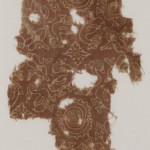
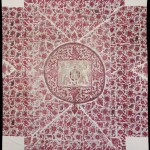
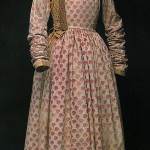
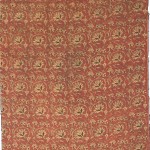
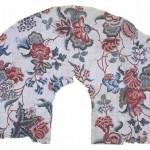
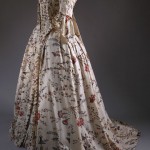
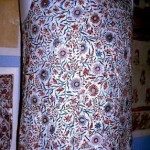
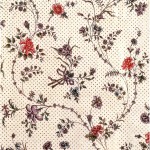
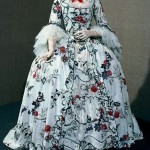
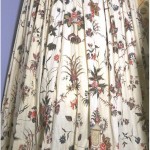
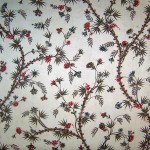
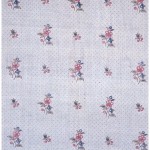
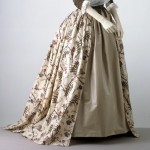

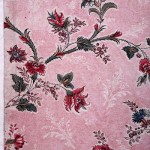
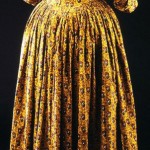
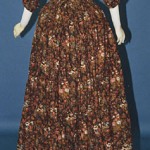
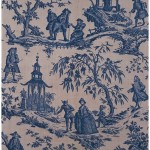
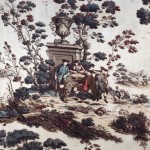
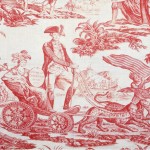
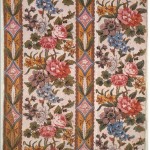
very helpful
You might be interested in the new exhibit at the V and A. A man’s coat, in velvet “toile” fabric. I have photos if you are interested, although behind glass, as usual.
You may be interested in a book I have about the French factory. A number of garments are illustrated with toile fabrics. So whilst many have not survived these fabrics were used at least for the odd jacket.
I am new to re-enacting and am finding it difficult to view or read about any existing costuming for lower classes. My 18th century impression is of a colonial New Hampshire farm woman, who would not wear the existing items of clothing that I see on view in museums or in books.
Could this be because the only existing pieces of clothing that have survived from the 1700’s were only worn once or twice, to parties or balls, not for milking cows, planting crops, tending to children, fighting Indians, and all the other farm work colonial farm women would be doing? Maybe the clothing of women of her class and social rank didn’t survive the rigors of use?
I’m perplexed! I would like to portray my character as authentically as possible.
I think you’re absolutely right. Also, the kinds of people who would save their clothes would be more likely to be the upper classes — and the kinds of clothes that get saved are things like wedding dresses.
Check out the blog “At the Sign of the Golden Scissors” — Hallie Larkin definitely does research on lower class costume, and focuses on New England. I’ll bet you’ll find something there!